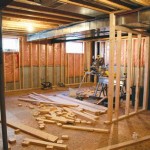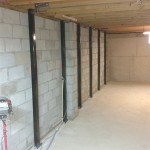How to Conquer the Challenge of Creating a Basement Bathroom
Transforming a basement into a functional and inviting space can be an exciting project, and adding a bathroom is often a crucial part of the transformation. However, creating a bathroom in a basement comes with unique challenges that require careful planning and attention to detail.
1. Addressing Moisture Concerns
Basements are prone to moisture issues due to their location below ground level. To prevent water damage and mold growth, it's essential to address moisture concerns effectively. Consider installing a sump pump to remove excess water, and ensure proper ventilation with exhaust fans and dehumidifiers.
2. Plumbing considerations
Plumbing a basement bathroom can be more complex than on higher floors due to the lower elevation. Plan for adequate drainage, and consider installing a macerating toilet if necessary. Consult with a licensed plumber to determine the feasibility of your plumbing design.
3. Waterproofing
Waterproofing is crucial to prevent water penetration through the walls and floor. Apply a waterproof membrane to all surfaces that will come into contact with water, including the shower, bath, and toilet areas. Ensure proper sealing around pipes and fixtures to prevent leaks.
4. Lighting
Basements are often dark due to limited natural light. Plan for ample artificial lighting to create a bright and inviting space. Consider using recessed lighting, wall sconces, and under-cabinet lighting to provide sufficient illumination.
5. Ventilation
Proper ventilation is essential to eliminate moisture, odors, and potentially harmful gases. Install an exhaust fan in the bathroom to circulate air and prevent condensation. Consider adding a vent fan to the basement as a whole to improve overall air quality.
6. Accessibility and Design
Plan the bathroom layout with accessibility in mind, ensuring there is enough space to move around comfortably. Consider installing grab bars in the shower and toilet areas for added safety. Choose fixtures and finishes that complement the overall basement aesthetic.
7. Insulation
Insulating the walls, ceiling, and floor of the bathroom helps maintain a comfortable temperature and reduces energy costs. Choose insulation materials that are resistant to moisture, such as closed-cell spray foam or rigid foam boards.
8. Permits and Inspections
Before starting any significant renovations, obtain the necessary permits from your local authority. Ensure that all electrical, plumbing, and structural work complies with building codes and standards. Schedule inspections at key stages of the project to ensure everything is up to code.
How To Plumb A Basement Bathroom Diy Family Handyman

7 Ways To Make A Small Basement Bathroom Look Bigger

7 Things To Consider When Planning A Basement Bathroom Sheffield Homes Finished Basements And More

A Basement Bathroom Renovation Merrypad

Adding A Bathroom To Basement Pros Cons Costs

Adding A Basement Bathroom What You Need To Know Make It Right

How To Finish A Basement Bathroom Pex Plumbing
:max_bytes(150000):strip_icc()/BasementBathroom750x1000-fddd3225e3db493aa6adcc1a88c0c082.jpg?strip=all)
9 Basement Bathroom Ideas

How To Diy Bathroom In Basement Without Breaking Concrete

How To Make A Basement Bathroom 27 Examples Cover Digsdigs Design Add
Related Posts







